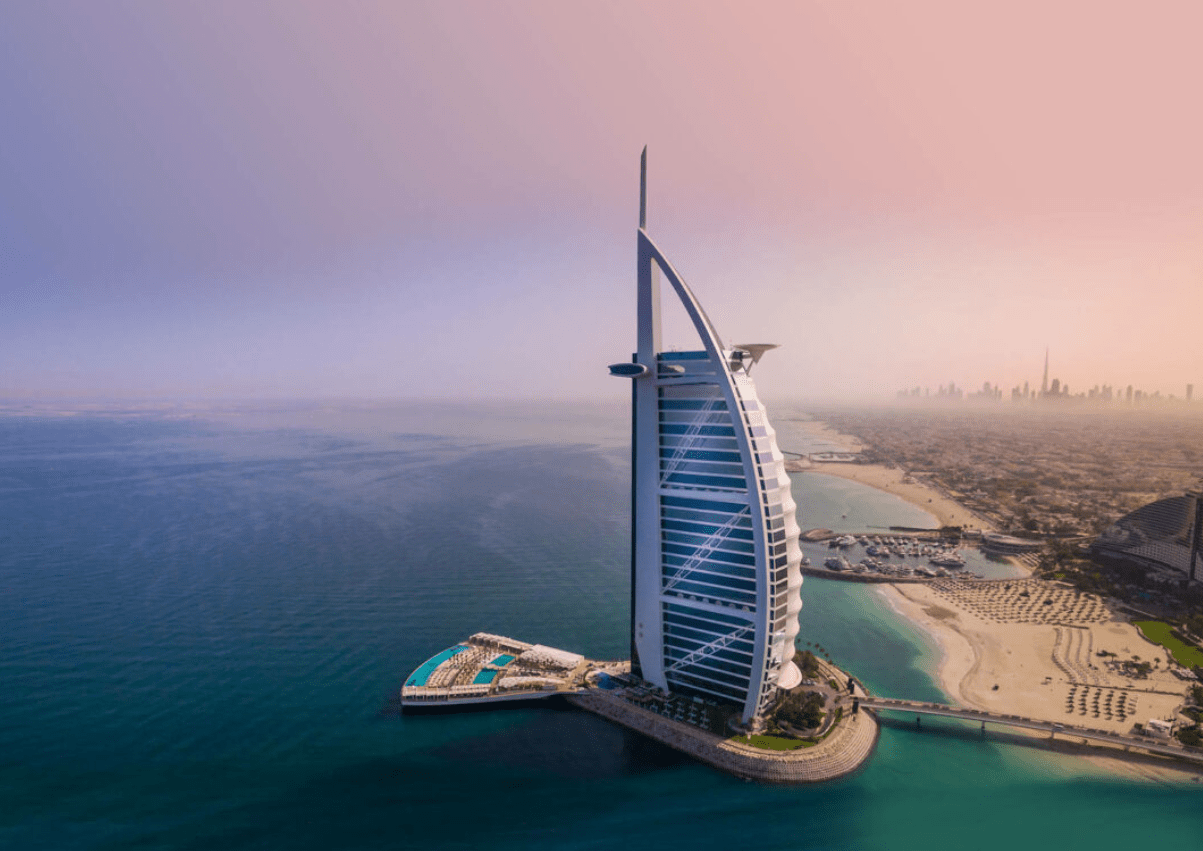The Burj Al Arab stands as an iconic symbol of luxury and innovation in Dubai. Recognized for its distinctive sail-shaped silhouette, it is often referred to as the world’s most luxurious hotel. Its unique architecture and opulent amenities attract visitors from around the globe, making it a must-see destination in the heart of the UAE.
Opened in 1999, this architectural marvel is built on an artificial island and boasts a range of extravagant services and experiences. Guests can indulge in fine dining, relax in lavish suites, and enjoy stunning views of the Arabian Gulf. The Burj Al Arab not only offers a luxurious stay but also represents Dubai’s ambition to redefine opulence and hospitality.
Exploring the Burj Al Arab reveals a blend of tradition and modernity. Visitors can experience a wealth of activities, from spa treatments to thrilling water sports, all while soaking in the hotel’s impressive surroundings. Diving into the intricacies of the Burj Al Arab provides insights into luxury travel and the evolution of modern architecture in one of the world’s fastest-growing cities.
Architecture and Design
The Burj Al Arab is renowned not only for its height but also for its distinctive architecture and design. The building exemplifies innovative engineering and luxurious aesthetics, combining both functionality and visual appeal in a unique manner.
Innovative Engineering
The Burj Al Arab’s structure stands on a man-made island, supported by a reinforced concrete base and a uniquely designed “tornado” shape. This shape provides resistance against strong winds and ensures stability.
Designed by architect Tom Wright, the building features a lightweight, high-tech facade made from Teflon-coated fiberglass, which reflects sunlight while maintaining a comfortable interior temperature. The use of advanced materials and construction techniques allows it to achieve its iconic silhouette.
The engineering feat includes a large atrium that rises to a height of 180 meters, providing guests with breathtaking views and skylight illumination.
Interior Aesthetics
The interior design of the Burj Al Arab reflects opulence, with lavish materials such as gold leaf, marble, and silk. Each suite is uniquely adorned, featuring high ceilings and spacious living areas.
A notable feature is the atrium, which is filled with a cascade of indoor waterfalls and adorned with luxurious furnishings. Fine art pieces, including sculptures and paintings, are displayed throughout the hotel, enhancing its artistic appeal.
Guests experience a luxurious ambiance created by the use of rich colors and textures, promoting a sense of indulgence and comfort.
Exterior Features
Visually striking, the exterior of the Burj Al Arab resembles a billowing sail, symbolizing both luxury and progress. Its height of 321 meters makes it one of the tallest hotels globally.
The building’s facade features a sleek, reflective surface that changes colors with the light, creating an impressive sight at night. Illuminated by thousands of LED lights, its outline becomes a focal point on the Dubai skyline.
The surrounding landscape includes carefully manicured gardens and private beach access, enhancing the hotel’s exclusivity and appeal.
Construction History
The Burj Al Arab’s construction involved detailed planning and innovative engineering techniques. Its journey began with initial concepts and evolved through various phases, ultimately resulting in its status as a luxury hotel icon.
Initial Concept
The idea for the Burj Al Arab originated in the early 1990s. Designed by architect Tom Wright of the WS Atkins firm, the concept aimed to create a building that represented the spirit of Dubai as a modern, affluent city. The structure’s sail-like silhouette symbolized maritime heritage and luxury.
Initially, the project faced skepticism regarding its feasibility due to its unique shape and location on an artificial island. However, the vision for an ultra-luxurious hotel attracted significant investment and support from the Dubai government, setting the stage for development.
Development Phases
Construction began in 1994 and involved significant logistical challenges. The foundation required extensive work, including the creation of a special 230,000 cubic meters of sand to form the artificial island. This effort took over three years and involved dredging and pumping sand into the Persian Gulf.
Once the foundation was secure, construction progressed rapidly. Workers employed advanced technology and materials to elevate the hotel’s structure. The use of a unique prefabrication method allowed for faster assembly. By 1999, the hotel reached its final height of 321 meters, becoming one of the tallest hotels in the world.
Completion and Opening
Burj Al Arab opened to guests on December 1, 1999. The opening ceremony featured an extravagant celebration showcasing its luxury and exclusivity.
The hotel offered sumptuous amenities, including lavish suites, fine dining, and unique features like a helipad. Its opulent design attracted global attention and positioned it as a hallmark of luxury accommodations in Dubai.
The Burj Al Arab quickly became an architectural and hospitality icon, setting a benchmark for luxury worldwide.
Accommodations and Facilities
Burj Al Arab offers a unique blend of luxury and advanced services, ensuring an exceptional experience for its guests. The accommodations feature lavish suites, while exclusive services cater to individual needs. A range of recreational amenities is available for relaxation and leisure activities.
Luxury Suites
The Burj Al Arab features 202 luxurious suites, each designed to provide supreme comfort and style. Ranging from the Deluxe One-Bedroom Suite to the Royal Two-Bedroom Suite, each space boasts stunning views of the Arabian Gulf.
Key features include:
- Spacious layouts: Suites start at 170 square meters.
- High-end furnishings: Suites include custom-designed furniture and rich fabrics.
- Private check-in: Guests receive an individualized welcome experience.
Each suite comes equipped with state-of-the-art technology, including an iPad-controlled room environment. Guests appreciate the large marble bathrooms and personal butlers available 24/7.
Exclusive Services
Burj Al Arab prioritizes tailored services to meet the needs of its guests. The hotel provides butler service, ensuring personalized attention throughout the stay.
Other exclusive offerings include:
- Private yacht charters: Enjoy a unique experience exploring the coastline.
- Personal shopping: Shoppers can receive assistance from dedicated staff for a seamless experience.
- Fine dining reservations: Expert concierges help guests secure tables at top restaurants.
Additional services, such as luxury car transfers and private jet arrangements, further enhance the guest experience, making every stay unforgettable.
Recreational Amenities
Guests of the Burj Al Arab can enjoy numerous recreational facilities designed for relaxation and leisure. The hotel features an expansive infinity pool overlooking the Gulf, ideal for unwinding in a picturesque setting.
Key amenities comprise:
- Talise Spa: Offering a variety of treatments and therapies for holistic wellness.
- Private beach access: Guests can relax and enjoy sunbathing in an exclusive area.
- Water sports: A range of activities, including jet skiing and parasailing, are available.
Fitness enthusiasts can utilize a fully equipped gym, while a variety of dining options provide guests with multiple culinary experiences throughout their stay.
Culinary Experiences
Dining at the Burj Al Arab offers a mix of high-end restaurants, exquisite ambiance, and unique menus tailored for an unforgettable experience. Each aspect enhances the culinary offerings, providing guests with exceptional meals in a stunning environment.
Signature Restaurants
The Burj Al Arab boasts several renowned dining establishments. Al Muntaha is located on the 27th floor, offering panoramic views alongside a modern European menu crafted by acclaimed chefs. Nathan Outlaw at Al Mahara specializes in seafood and showcases a stunning aquarium. Junsui, with its vibrant Asian cuisine, presents dishes influenced by various culinary traditions. Each venue emphasizes quality ingredients, designed to create a memorable dining experience.
Dining Ambiance
The ambiance within the Burj Al Arab sets a sophisticated tone. Rich fabrics, elegant decor, and stunning views create a captivating atmosphere. Each restaurant is uniquely designed to enhance guest experiences. For example, Al Mahara features an aquatic theme with floor-to-ceiling windows. Meanwhile, Al Muntaha boasts stunning city vistas. The combination of aesthetics and service elevates the entire culinary journey.
Unique Menus
Unique menus reflect the commitment to culinary excellence. Seasonal ingredients play a significant role, ensuring freshness in every dish. Signature offerings like truffle risotto, lobster thermidor, and customizable tasting menus allow personalization for guests. Wine pairings include selections from some of the finest vineyards worldwide. The diverse range of choices caters to various palates, making each meal a tailored experience.
Location and Accessibility
Burj Al Arab is strategically situated on its own island, offering a unique and iconic presence along the Dubai coastline. Its accessibility is enhanced by a variety of transport options for visitors.
Geographic Setting
Burj Al Arab stands off the coast of Dubai, connected to the mainland by a private bridge. Located at Jumeirah Beach, it offers stunning views of the Arabian Gulf. The hotel is surrounded by luxurious resorts and recreational facilities, making it a premium destination.
The geographical setting ensures that Burj Al Arab is easily visible from several coastline viewpoints. Its distinctive sail-shaped silhouette has become one of Dubai’s most recognized landmarks. This premium location contributes to its status as a symbol of luxury and exclusivity.
Transport Links
Burj Al Arab is easily accessible via multiple transportation options. The location is serviced by taxis and ride-sharing services, providing convenient access for visitors from around the city.
For a more luxurious experience, guests can opt for luxury car rentals available without a deposit at GMZ Car Rental. Options include high-end brands like Lamborghini, Mercedes, Ferrari, and Aston Martin, ensuring an impressive arrival at the hotel.
Additionally, the location is near major roadways, allowing straightforward connections to Dubai’s airports and other attractions. The combination of transport links enhances the overall accessibility of the Burj Al Arab, making it a favored choice for travelers seeking luxury.
Cultural Significance
The Burj Al Arab is not just an architectural landmark; it represents a cultural emblem of luxury and innovation in Dubai. Its design and prestige resonate with themes of prosperity and global recognition, establishing a connection between local heritage and international appeal.
Symbol of Prosperity
The Burj Al Arab has become synonymous with the economic boom of Dubai. Completed in 1999, its unique sail-like structure reflects the city’s rise as a global financial hub.
The hotel’s luxurious accommodations and high-profile clientele illustrate its status. With a room rate that often exceeds $1,500 per night, it caters to those seeking high-end experiences.
It symbolizes the wealth generated by oil and tourism in the region. Moreover, local initiatives often highlight the Burj Al Arab in promotional materials, reinforcing its role in the local economy and identity.
Global Recognition
Globally, the Burj Al Arab is recognized as one of the most luxurious hotels in the world. It regularly appears in travel guides, documentaries, and media as a symbol of modern architecture.
Its design, by architect Tom Wright, has influenced other structures worldwide, creating a distinct architectural language that blends tradition with innovation.
The hotel has received numerous awards, including the “World’s Only 7-Star Hotel” designation. This acclaim enhances Dubai’s reputation as a tourist destination, drawing visitors eager to experience its luxury.
Economic Impact
The Burj Al Arab significantly influences Dubai’s economy through tourism and job creation. Its iconic status attracts millions of visitors annually, contributing to various sectors and boosting employment.
Tourism Growth
The Burj Al Arab is a major attraction in Dubai, drawing approximately 1.5 million visitors each year. Many of these tourists visit to experience its luxurious amenities and architectural marvel. The presence of the hotel enhances Dubai’s appeal as a premier travel destination.
Increased tourism leads to higher revenues for local businesses, including restaurants, shops, and entertainment venues. According to estimates, the tourism sector contributes around 11.5% to Dubai’s GDP, with iconic landmarks like the Burj Al Arab playing a pivotal role in this figure.
Employment Opportunities
The Burj Al Arab creates numerous job opportunities directly within the hotel. Positions range from hospitality roles, such as concierge and management, to technical jobs in maintenance and operations. Employment here supports a diverse workforce.
Moreover, the surrounding areas benefit as the hotel drives demand for services like transportation, catering, and retail. Indirect job creation extends to other sectors, resulting in thousands of jobs throughout the tourism industry. This impact strengthens the local economy and enhances workforce development initiatives.
Sustainability Efforts
The Burj Al Arab incorporates various sustainability initiatives aimed at reducing its environmental impact. The hotel integrates energy-efficient systems and promotes water conservation.
Key Initiatives:
- Energy Efficiency: The building uses a state-of-the-art cooling system to minimize energy consumption. LED lighting is utilized throughout the property.
- Water Management: A rainwater collection system helps in irrigation, reducing dependency on potable water. The hotel also employs low-flow fixtures to conserve water.
- Waste Reduction: The Burj Al Arab follows a waste segregation policy. It actively recycles materials and reduces single-use plastics within its operations.
- Sustainable Sourcing: The hotel prioritizes locally sourced products in its restaurants. This approach supports local farmers and reduces transportation emissions.
- Green Certifications: The hotel has received recognition for its efforts, including certifications related to environmental management. These accolades underscore its commitment to sustainability.
The Burj Al Arab remains focused on continual improvement in sustainability practices, reflecting a responsible approach to luxury hospitality. Efforts are regularly reviewed to align with best practices in environmental stewardship.
Guest Reviews and Ratings
Guests have shared a variety of experiences while staying at the Burj Al Arab. The hotel consistently receives high ratings for its luxurious accommodations and exceptional service.
Ratings Summary
| Aspect | Average Rating (out of 5) |
|---|---|
| Service | 4.9 |
| Cleanliness | 4.8 |
| Amenities | 4.7 |
| Location | 4.8 |
| Dining Options | 4.6 |
Many guests highlight the attentive staff and personalized service as standout features. Reviewers often mention that team members anticipate needs and provide tailored experiences.
Guests frequently express satisfaction with the variety of dining options available. Meals at the hotel’s restaurants receive praise for quality and presentation.
The interior design and opulence of the hotel contribute to its positive reviews. Visitors appreciate the breathtaking views and attention to detail in their rooms.
Some reviews mention the exclusivity and privacy offered by the hotel. This aspect attracts visitors seeking a refined getaway.
Online platforms reflect a strong overall sentiment, with a majority of guests recommending the Burj Al Arab for luxury travel. While a few comments note high pricing, many agree that the experience justifies the cost.
Frequently Asked Questions
This section addresses key inquiries about the Burj Al Arab, covering accommodation costs, unique features, dining options, visitations, ownership, and its star rating.
How much does it cost to stay one night at the Burj Al Arab?
The price for a one-night stay at the Burj Al Arab varies significantly. Rates typically start around AED 3,000 and can exceed AED 25,000, depending on the suite type and season.
What are the unique features that make Burj Al Arab special?
The Burj Al Arab is known for its distinctive sail-shaped silhouette. It offers luxurious suites, lavish amenities, and a private beach. Additionally, it features a helipad and an underwater restaurant.
Can non-guests dine at the restaurants inside Burj Al Arab and if so, how can they make a reservation?
Yes, non-guests can dine at the Burj Al Arab’s restaurants. Reservations can be made through the hotel’s official website or by calling their dining reservations team.
Is it possible to visit the Burj Al Arab without booking a room?
Visitors can access the Burj Al Arab through specific experiences, such as afternoon tea or dining. These reservations allow non-guests to experience the hotel’s luxurious atmosphere.
Who is the owner of the Burj Al Arab hotel?
Burj Al Arab is owned by Jumeirah Group, a subsidiary of Dubai Holdings. The hotel has been a prominent symbol of luxury hospitality since its opening in 1999.
Does the Burj Al Arab hold the title of the only 7-star hotel in the world?
The Burj Al Arab is often referred to as a 7-star hotel due to its opulence. While the official hotel rating system caps at 5 stars, this designation highlights its extraordinary luxury and service.



0 Comment